

Iron (Fe) The Element Iron. [Click for Isotope Data] Atomic Number: 26 Atomic Weight: 55.845.

Manganese (Mn) - Chemical properties, Health and Environmental effects. Manganese is a very common compound that can be found everywhere on earth.
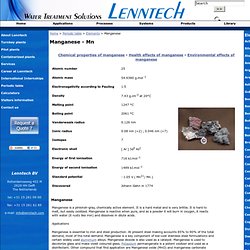
Manganese is one out of three toxic essential trace elements, which means that it is not only necessary for humans to survive, but it is also toxic when too high concentrations are present in a human body. When people do not live up to the recommended daily allowances their health will decrease. But when the uptake is too high health problems will also occur. The uptake of manganese by humans mainly takes place through food, such as spinach, tea and herbs. The foodstuffs that contain the highest concentrations are grains and rice, soya beans, eggs, nuts, olive oil, green beans and oysters.
Manganese effects occur mainly in the respiratory tract and in the brains. Because manganese is an essential element for human health shortages of manganese can also cause health effects. Chronic Manganese poisoning may result from prolonged inhalation of dust and fume. Facts about CHROMIUM. The Element Chromium. [Click for Isotope Data]
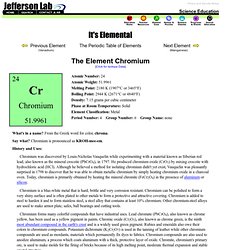
Titanium Facts - Periodic Table of the Elements. The Element Silver. Gold (Au) Periodic Table of the Elements. Gold: the essentials Most metals are metallic grey or silvery white whereas gold is characteristically a metallic yellow colour, in other words gold-coloured.
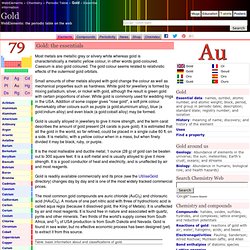
Caesium is also gold coloured. The gold colour seems related to relativistic effects of the outermost gold orbitals. Small amounts of other metals alloyed with gold change the colour as well as mechanical properties such as hardness. White gold for jewellery is formed by mixing palladium, silver, or nickel with gold, although the result is green gold with certain proportions of silver. Gold is usually alloyed in jewellery to give it more strength, and the term carat describes the amount of gold present (24 carats is pure gold). It is the most malleable and ductile metal; 1 ounce (28 g) of gold can be beaten out to 300 square feet. Gold is readily available commercially and its price (see the UtiliseGold directory) changes day by day and is one of the most widely tracked commercial prices. Periodic Table of the Elements. Platinum: the essentials Ruthenium, rhodium, palladium, osmium, iridium, and platinum together make up a group of elements referred to as the platinum group metals (PGM).

Platinum is a beautiful silvery-white metal, when pure, and is malleable and ductile. It has a coefficient of expansion almost equal to that of soda-lime-silica glass, and is therefore used to make sealed electrodes in glass systems. The metal does not oxidise in air. It is insoluble in hydrochloric and nitric acid, but dissolves when they are mixed as aqua regia, forming chloroplatinic acid (H2PtCl6), an important compound. Platinum: historical information Platinum was discovered by Antonio de Ulloa at 1735 in South America.
The metal was used by pre-Columbian Indians but platinum was "rediscovered" in South America by Ulloa in 1735 and by Wood in 1741. Platinum is one of the elements which has an alchemical symbol, shown below (right, {{floatR}} Platinum: physical properties Read more » » The Element Platinum. [Click for Isotope Data] Atomic Number: 78 Atomic Weight: 195.084 Melting Point: 2041.55 K (1768.4°C or 3215.1°F) Boiling Point: 4098 K (3825°C or 6917°F) Density: 21.46 grams per cubic centimeter Phase at Room Temperature: Solid.
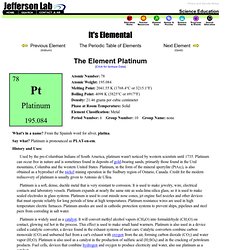
The Element Gold. [Click for Isotope Data] Atomic Number: 79 Atomic Weight: 196.966569.

Copper (Cu) What is Copper? The Element Copper. Nickel (Ni) Periodic Table of the Elements. Nickel: the essentials Nickel is found as a constituent in most meteorites and often serves as one of the criteria for distinguishing a meteorite from other minerals.
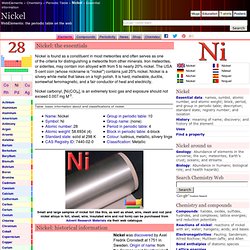
Iron meteorites, or siderites, may contain iron alloyed with from 5 to nearly 20% nickel. The USA 5-cent coin (whose nickname is "nickel") contains just 25% nickel. Nickel is a silvery white metal that takes on a high polish. It is hard, malleable, ductile, somewhat ferromagnetic, and a fair conductor of heat and electricity. Nickel carbonyl, [Ni(CO)4], is an extremely toxic gas and exposure should not exceed 0.007 mg M-3.
Small and large samples of nickel foil like this, as well as sheet, wire, mesh and rod (and nickel alloys in foil, sheet, wire, insulated wire and rod form) can be purchased from Advent Research Materials via their web catalogue. Nickel: historical information Nickel was discovered by Axel Fredrik Cronstedt at 1751 in Sweden. The Element Nickel. [Click for Isotope Data] Atomic Number: 28 Atomic Weight: 58.6934 Melting Point: 1728 K (1455°C or 2651°F) Boiling Point: 3186 K (2913°C or 5275°F) Density: 8.912 grams per cubic centimeter Phase at Room Temperature: Solid.

Cobalt (Co) Periodic Table of the Elements. Zinc (Zn) Zirconium Facts - Periodic Table of the Elements.